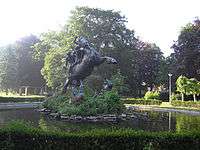Aloïs de Beule
Aloïs De Beule (27 August 1861, Zele - 15 December 1935, Ghent) was a Belgian sculptor.
Biography

Aged ten he entered his father's shoemaking business. He studied at the Gentse Academie and the Sint-Lucasschool in Ghent where he won the first prize in sculpture in 1888. In 1889 he and his brother Emile De Beule set up a studio together. They began in a barn in the Sint-Pietersdorp (Sint-Pieters-Aalst) district of Ghent, on the spot where Het Ros Beiaard stands - he produced that sculpture for the World Exhibition of 1913 in Ghent, in collaboration with Domien Ingels, an animal sculptor, and it proved a breakthrough for both of them. De Beule was also later commissioned by the architects Jean-Baptiste Bethune and Valentin Vaerwyck. Her pupils included Geo Verbanck, Leo Sarteel, Oscar Sinia, Jules Vits and Modeste Van Hecke
Works
- The monument to the Peasants' War in the church square in Overmere
- Ros Beiaard
- Bronze statue of Adriaan Poirters in Oisterwijk
- Stations of the Cross for (among others) the Sint-Jacobskerk in Ghent, the Sint-Quintinuskerk in Zonhoven, the Church of the Annunciation in London, St Anne's Church in Liverpool[1] and St Augustine's Church in Ramsgate
- Statue of the Sacred Heart in the Emmaplein in 's-Hertogenbosch
- Busts of (among others) Antoon Stillemans, Hendrik Conscience and Prudens Van Duyse
- Monument to the fallen in the town park in Ruiselede, 1923
- Crucifix and Calvary in the pilgrimage route in Bareldonk Berlare
- Bronze statue of Christ the King in the church in Ophasselt, near Geraardsbergen
Gallery
-

Chatelaine du XVI
-
'Fury of Ypres'
-

Ros Beiaard in Ghent
-
Sacred Heart, Winssen
References
External links
| Wikimedia Commons has media related to Alois De Beule. |